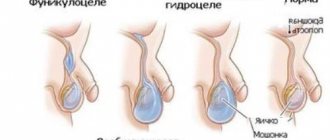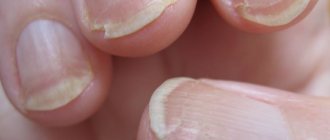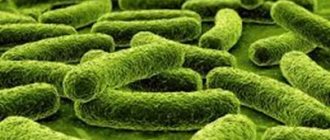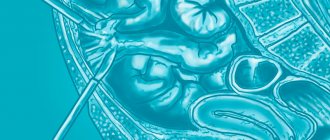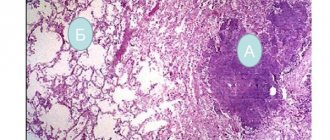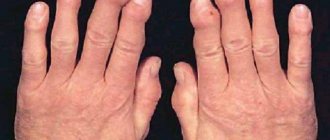Typhoid fever
Ulcer
Vomit
Diarrhea
16868 January 21
IMPORTANT!
The information in this section cannot be used for self-diagnosis and self-treatment.
In case of pain or other exacerbation of the disease, diagnostic tests should be prescribed only by the attending physician. To make a diagnosis and properly prescribe treatment, you should contact your doctor. Typhoid fever: causes, symptoms, diagnosis and treatment methods.
Definition
Typhoid fever is an acute infectious disease manifested by fever and symptoms of intoxication.
Its causative agents are the bacteria Salmonella Typhi
, which are found in water, meat and dairy products. In the human body, bacteria begin to secrete endotoxin, which causes symptoms of the disease.
Bacteria are extremely resistant to unfavorable environmental factors and sudden temperature changes, but they die when boiled.
Causes of typhoid fever
Sources of infection are most often sick people or carriers of bacteria.
The transmission mechanism is fecal-oral, the pathogen is released into the environment with urine and feces; often the bacteria remain on poorly washed hands and enter the mouth through food.
Rarely and mainly among children, the disease can spread through contact and household contact - through dishes and hygiene items. A significant role in the spread of typhoid fever is played by flies, which carry microparticles of feces on their legs, so the peak incidence occurs in the summer-autumn period.
Typhoid fever is found everywhere, but it is most common in countries with poor sanitation and hygiene, in overpopulated cities with no access to clean drinking water.
Classification of the disease
There are three forms of the disease:
- Typical course. It is characterized by a slowly increasing fever, severe symptoms of intoxication, and typical lesions of the gastrointestinal tract and skin.
- Atypical course:
- erased form (the disease is milder, fever may be absent, symptoms of damage to the gastrointestinal tract are mild);
- asymptomatic form (there are no symptoms at all, but specific antibodies are detected in the blood);
- carriage of Salmonella Typhi
.
- Rare forms (pneumotyphoid, meningotif, nephrotyphoid, colotyphoid, appendicotyphoid, cholangiotyphoid, typhoid gastroenteritis).
The typical form of typhoid fever varies in severity:
mild, moderate and severe.
According to the nature of the flow, they are distinguished:
- Cyclic typhoid fever (the most common variant) is characterized by cyclical pathological changes in the intestines for an average of 6 weeks. The cycle goes through stages from the gradual formation of ulcers on the intestinal mucosa to their complete healing and recovery of the patient.
- Recurrent typhoid fever (occurs in 10–15% of cases) - characterized by the resumption of symptoms after a period of normalization of temperature for at least 14 days. On average, up to 5 relapses are observed, but they are milder than the first manifestation of the disease.
Based on the presence of complications, a distinction is made between
complicated and uncomplicated typhoid fever.
Symptoms of typhoid fever
Symptoms of typhoid fever usually develop 1-2 weeks after a person becomes infected with Salmonella typhi
.
In the typical course of the disease, there is an initial period that lasts about a week and is characterized by daily increasing fever (body temperature up to 40–40.5 ° C) and symptoms of intoxication.
Symptoms of intoxication include headache, weakness and fatigue, muscle pain, sweating, loss of appetite and weight, and sleep disturbances.
In some cases, there is a decrease in blood pressure, a dry cough, pain in the lower abdomen and constipation.
At the height of the disease, patients complain of lethargy, drowsiness, and stupor. Characteristic symptoms are pale skin and puffiness of the face.
Damage to the gastrointestinal tract is manifested by a white coating and swelling of the tongue. There is a characteristic rumbling, pain, bloating in the abdomen, the stool becomes liquid and greenish.
On the 8th–10th day of illness, a reddish rash appears on the skin of the chest, abdomen, and less often on the extremities.
The acute stage of the disease lasts about 1–2 weeks.
During the recovery period, the patient's appetite returns and sleep normalizes. However, pronounced weakness and emotional instability remain. Low-grade body temperature (not higher than 37.5°C) may persist for a long time.
Diagnosis of typhoid fever
Establishing a diagnosis begins with examining the patient, collecting complaints, medical history, mandatory recording of previous trips, contacts with sick people, and consumption of contaminated food.
To confirm the diagnosis, the doctor will prescribe laboratory and instrumental examination methods:
- Clinical blood test with a detailed leukocyte formula (helps to identify inflammatory changes).
General information about the disease
The causative agent of typhoid fever is the bacterium Salmonella typhi. The infection is transmitted from person to person through water, food or contact with contaminated surfaces. With strict adherence to personal hygiene rules, the risk of infection is minimized.
The infection affects the lymphatic system and digestive tract, spreading throughout the body through blood and lymph. Thanks to the presence of flagella, the bacterium actively moves within the intestine and penetrates through its walls into the blood vessels.
Typhoid bacillus can persist outside the human body for a long time. It does not encapsulate and does not leave spores, but when exposed to an unfavorable environment, it transforms into the cell-free L-form, which increases the resistance of the microorganism to drugs. However, it quickly dies when boiled and upon contact with antiseptics - alcohol, chlorine-containing substances and alkalis. At low temperatures, the bacterium can remain viable for several months.
How to cure
Since the infection is extremely virulent, and the disease is severe and often complicated, treatment of typhoid fever must be carried out in the infectious diseases department of the hospital, in conditions of complete isolation. During illness, the patient remains in bed and does not leave the infectious disease ward. Therapy continues until the patient's body temperature returns to normal for ten consecutive days and includes:
- taking antibiotics (orally or by injection);
- replacement of fluid losses (orally or intravenously);
- a gentle diet with a high content of protein products;
- in case of intestinal perforation - surgical removal of a section of intestine with multiple injuries or closure of a single perforation with drainage of the peritoneum.
Taking antibacterial drugs continues for several months. Constant monitoring of patients' condition allows for timely detection of complications and prevention of their development. After discharge from the hospital, the patient is monitored at the dispensary for a certain time.
How does infection occur?
The main cause of typhoid fever is the penetration of infection into the human body through the oral cavity. Most often this happens when:
- drinking unboiled water containing the bacteria Salmonella typhi;
- swimming in a contaminated body of water;
- consumption of food products containing pathogenic bacteria - milk and dairy products, jelly, poorly fried minced meat, unwashed vegetables and fruits;
- contact with surfaces on which particles of saliva, urine or feces of an infected person remain.
Sometimes the infection is transmitted by flies, which on their legs transfer bacteria from the patient’s feces to food. There are known cases of mother infecting a child through breast milk. The source of infection is always a person - a patient in the acute phase, during an exacerbation, or a carrier of the bacteria. The release of bacteria into the external environment begins already on the seventh day after infection.
References
1. Bogomolov, B.P. Infectious diseases: Textbook for students of medical universities / M.: Moscow State University Publishing House, 2009. 2. Clinical recommendations (treatment protocol) for providing medical care to children with typhoid fever. FSBI NIIDI FMBA of Russia M.: 2015. - P. 85.
3. Andrews, J., Ryan, E. Diagnostics for invasive Salmonella infections: Current challenges and future directions / Vaccine. 2015. - P. 8-15. doi:10.1016/j.vaccine.2015.02.030. 4. Crump, J, Sjölund-Karlsson, M, Gordon, [et al.]. Epidemiology, Clinical Presentation, Laboratory Diagnosis, Antimicrobial Resistance, and Antimicrobial Management of Invasive Salmonella Infections / Clinical Microbiology Reviews. 2015. - Vol. 28(4). — P. 901-937. doi: 10.1128/CMR.00002-15. 5. Heiman, F, Horby, P, Woodall, J. Atlas of Human Infectious Diseases / First Edition // Blackwell Publishing Ltd, 2012.
Diagnostics
Photo: lebzdrav.ru
The main causative agent of typhoid fever is Salmonella. The bacterium enters the human body through the mouth. The microbe then passes through the large intestine and lymph nodes. It is at this stage that bacteria multiply and enter the circulatory system. In this regard, intoxication syndrome develops.
Diagnosis of typhoid fever: external signs
External indicators are very important when identifying typhoid fever. At the initial stage (duration of the disease is 3-5 days), the patient’s body temperature will reach the highest levels. The face is swollen, the skin is dry, bluish, and roseola-shaped pimples may appear in the chest area.
The patient's tongue is swollen and dry, covered at the base with a blue-gray film, and tooth marks may be found along the edges. The abdomen is swollen, there is rumbling and pain. Testing for typhoid fever in the first 2 days shows a normal white blood cell count. At the last stage of the disease, lymphocytosis, leukopenia, a significant increase in ESR and neutropenia are detected.
Diagnosis using laboratory tests
The most reliable method for detecting the disease is to determine the amount of Salmonella blood culture isolated. Early diagnosis allows one to obtain positive results throughout the entire period of the patient's febrile state.
A typhoid fever test should be performed daily for 3 days. It is recommended to carry out examination on the 1st day before taking antimicrobial drugs. Blood for typhoid fever is taken from the patient in the amount of 5-10 ml per 100 ml of bile-containing medium. For diagnostic purposes, tests are carried out until the patient’s temperature returns to normal. Pus, sputum, exudate fluid, and feces are also subject to examination. They are usually taken for analysis in the 2nd or 3rd week from the onset of the disease. Studies can be repeated if necessary every 5-7 days.
It is worth saying that the bacterial bacillus that caused the disease can be found in the urine and feces not only of a patient with typhoid fever, but also of bacteria carriers during any febrile conditions.
Serological testing for typhoid fever is also of great importance in diagnosis. Research is carried out 7-10 days from the onset of the disease. Serodiagnosis of typhoid fever is aimed at identifying the accumulation of O-antibody titers.
Thus, a positive response with type Vi antigen indicates prolonged carriage of the pathogen. A positive reaction to typhoid fever with the H-antigen indicates that the patient had suffered the disease previously or had been vaccinated. Recently, the disease is increasingly diagnosed using ELISA.
Testing for typhoid fever is carried out by taking stool and bile samples. In this case, diagnosis is aimed at identifying typhoparatyphoid carriage.
Remember: only a doctor should make a diagnosis, since many signs of the abdominal type correspond to symptoms of other diseases. Self-diagnosis (and especially treatment) can lead to irreversible consequences.
Specific prevention of the abdominal type consists of mandatory vaccination enriched with the Vi antigen. Vaccination is carried out for adults and children under 7 years of age. Mandatory and graded vaccination against typhoid fever is carried out for children under 15 years of age and adults.
As for nonspecific prevention, in this case general sanitary measures should be carried out aimed at combating flies (frequent carriers of bacteria), improving the quality of water supply and sanitary cleaning of populated areas, etc.
Treatment
Photo: cbroadcasting.net
Typhoid fever is diagnosed and treated by infectious disease doctors. All patients undergo therapy in an inpatient setting. Hospitalization is required for the following reasons:
- the disease is infectious;
- there is a risk of infecting others;
- the development of dangerous complications is possible;
- Availability of quality care is the key to a complete successful recovery.
Patients are prescribed a special diet. Etiotropic and symptomatic treatment measures are carried out. Procedures to combat typhoid fever are aimed at neutralizing the infection, increasing the body's immunity and stopping the transmission of the infectious disease. It is also necessary to pay attention to prevention.
Diet
Therapeutic nutrition has a gentle effect on the intestines and does not cause fermentation (putrefactive) processes after consumption. In order for food to be easily digestible, it must be semi-liquid (broths, soups) or rubbed through a sieve. The diet for typhoid fever is high in calories. Frequent consumption of food in small portions is recommended. Drinking plenty of fluids is recommended, preferably warm tea.
Patient care
In addition to the above measures, the patient is recommended to rest in bed for 7-10 days. The prescription must be strictly followed, otherwise straining the abdominal muscles may lead to bleeding or perforation of the intestine. Subsequently, gradual activation is carried out. It is necessary to observe hygienic conditions, both in patient care and in nutrition. Discharge is permitted no earlier than 23 days from the date of admission.
Treatment of typhoid fever in children
Children and adolescents with this disease are also subject to mandatory hospitalization in a hospital. Patients are usually isolated in separate rooms to prevent outbreaks and spread of infection.
During the period of fever, an infectious disease doctor prescribes bed rest and careful care of the skin and oral cavity. A special diet with the necessary nutrients, vitamins, and microelements is prescribed. The specialist uses antibiotics and symptomatic medications in appropriate age-appropriate dosages. In case of severe intoxication, infusion therapy is carried out.
Vaccination
According to epidemiological indications, vaccination of the population is carried out by subcutaneous injection of a liquid anti-typhoid drug into the shoulder. WHO recommends three types of vaccines. Each of them has its own characteristics, a certain adaptation period and dosage.
Vaccination is recommended for those traveling abroad to the countries of Latin America, Africa, and Asia. The optimal time for administering the vaccine is a week before the trip. The average duration of vaccination is 3 years. If you have a history of this procedure, you should consult your doctor about the age of the last vaccination and the relevance of the new one.
Prevention of typhoid fever
As part of prevention, the following activities are carried out:
- It is necessary to strictly follow established sanitary and hygienic rules (from maintaining personal hygiene to organizing water supply).
- You should wash your hands often with warm water and soap.
- According to indications, you should get the appropriate vaccination.
- In areas with poor sanitation, it is recommended to consume only bottled water.
- When the first signs of the disease appear, you should immediately consult a doctor.
Disease prevention also includes supplying the population with high-quality water, timely removal of garbage and sewage from populated areas, insect control, and isolation of infected people.
Diagnosis methods
The most reliable methods for diagnosing typhoid fever today are laboratory tests.
- Agglutination reaction to detect antibodies to the Salmonella typhi antigen. This test is carried out two weeks after infection. Its disadvantage is the possibility of a false positive result if another Salmonella bacterium is present in the body.
- Indirect hemagglutination. The test can detect typhoid fever during the first week of illness.
- ELISA. This method is highly accurate and allows you to determine the presence of any antibodies to bacterial antigens. Its advantage is the ability to conduct the test at all stages of the disease, including during the recovery period.
For general clinical and bacteriological studies, samples of the patient’s blood, feces and urine are taken. During the last phase of the disease, duodenal intubation is performed, during which a sample of the contents of the duodenum is taken.
